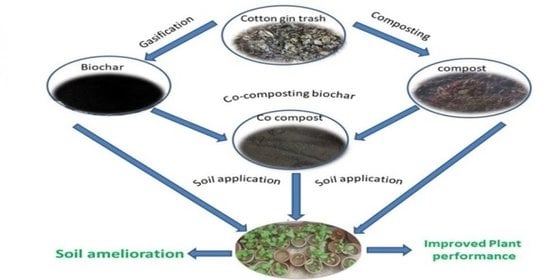Valorization of Cotton Gin Trash through Thermal and Biological Conversion for Soil Application
Abstract
:1. Introduction
2. Methodology
2.1. Characterization of Feedstock
2.2. Preparation of Biochar
2.3. Preparation of Compost and Co-Compost
2.4. Characterization of Thermal and Biological Products
2.5. Greenhouse Experiment
2.6. Statistical Analysis
3. Results and Discussion
3.1. Characteristics of Biochar, Compost and Co-Compost
3.2. Effect of Soil Amendments on Growth of Plants
3.3. Post-Harvest Soil Analysis
4. Conclusions
Supplementary Materials
Author Contributions
Funding
Institutional Review Board Statement
Informed Consent Statement
Data Availability Statement
Acknowledgments
Conflicts of Interest
References
- OECD-FAO. Agricultural Outlook 2019–2028; OECD Publishing: Paris, France, 2019. [Google Scholar] [CrossRef]
- Hamawand, I.; Sandell, G.; Pittaway, P.; Chakrabarty, S.; Yusaf, T.; Chen, G.; Seneweera, S.; Al-Lwayzy, S.; Bennett, J.; Hopf, J. Bioenergy from cotton industry wastes: A review and potential. Renew. Sustain. Energy Rev. 2016, 66, 435–448. [Google Scholar] [CrossRef]
- Sollenberger, L.E.; Reis, R.A.; Nussio, L.G.; Chambliss, C.G.; Kunkle, W.E. Conserved forage. In Warm-Season (C4) Grasses. Agronomy Monograph; More, L.E., Burson, B.L., Sollenberger, L.E., Eds.; Agronomy Journal: Madison, WI, USA, 2012; Volume 45, pp. 355–387. [Google Scholar] [CrossRef]
- Ismail, Z.Z.; Talib, A.R. Recycled medical cotton industry waste as a source of biogas recovery. J. Clean. Prod. 2016, 112, 4413–4418. [Google Scholar] [CrossRef]
- Fava, A. The “waste” with 2.5 million tons of potential. In Business-Emmaus Pennsylvania; Auburn University: Auburn, AL, USA, 2004; Volume 26, pp. 26–27. [Google Scholar]
- Mayfield, W. Gin trash utilization: What are the options? In Proceedings-Beltwide Cotton Conferences; National Agricultural Library: Beltsville, MD, USA, 1992; pp. 496–497. [Google Scholar]
- Higman, C.; van der Burgt, M. Gasification, 2nd ed.; Gulf Professional Publishing: Oxford, UK, 2008. [Google Scholar]
- Liu, X.; Farmer, M.; Capareda, S.; Schmitz, A.; Wilson, N.; Moss, C.; Zilberman, D. The Economic Feasibility of Electricity Generation from Biomass on the South Plains of Texas. In The Economics of Alternative Energy Sources and Globalization; Schmitz, A., Wilson, N., Moss, C., Bentham, D.Z., Eds.; Bentham eBooks: Anna Paulownalaan, The Netherlands, 2011; pp. 158–169. [Google Scholar]
- Wang, Y.; Villamil, M.B.; Davidson, P.C.; Akdeniz, N. A quantitative understanding of the role of co-composted biochar in plant growth using meta-analysis. Sci. Total Environ. 2019, 685, 741–752. [Google Scholar] [CrossRef]
- Fischer, D.; Glaser, B. Synergisms between compost and biochar for sustainable soil amelioration. In Management of Organic Waste; Sunil, K., Bharti, A., Eds.; InTech: Rijeka, Croatia, 2012; pp. 167–198. [Google Scholar]
- Agyarko-Mintah, E.; Cowie, A.; Singh, B.P.; Joseph, S.; Van Zwieten, L.; Cowie, A.; Harden, S.; Smillie, R. Biochar increases nitrogen retention and lowers greenhouse gas emissions when added to composting poultry litter. Waste Manag. 2017, 61, 138–149. [Google Scholar] [CrossRef]
- Dias, B.O.; Silva, C.A.; Higashikawa, F.A.; Roig, A.; Sanchez-Monedero, M.A. Use of biochar as bulking agent for the composting of poultry manure: Effect on organic matter degradation and humification. Bioresour. Technol. 2010, 101, 1239–1246. [Google Scholar] [CrossRef] [PubMed]
- Zimmerman, A.R. Abiotic and microbial oxidation of laboratory-produced black carbon (biochar). Environ. Sci. Technol. 2010, 44, 1295–1301. [Google Scholar] [CrossRef] [PubMed]
- ASTM D1762-84. Standard Test Method for Chemical Analysis of Wood Charcoal; ASTM International: West Conshohocken, PA, USA, 2007. [Google Scholar]
- Trautmann, N.M.; Kransy, M.E. Composting in the Classroom; Scientific Inquiry for High School Students; Cornell Waste Management Institute, Cornell University: Ithaca, NY, USA, 1997. [Google Scholar]
- Zhang, L.; Sun, X. Changes in physical, chemical, and microbiological properties during the two-stage co-composting of green waste with spent mushroom compost and biochar. Bioresour. Technol. 2014, 171, 274–284. [Google Scholar] [CrossRef] [PubMed]
- Rajkovich, S.; Enders, A.; Hanley, K.; Hyland, C.; Zimmerman, A.R.; Lehmann, J. Corn growth and nitrogen nutrition after additions of biochars with varying properties to a temperate soil. Biol. Fert. Soils 2012, 48, 271–284. [Google Scholar] [CrossRef]
- Brewer, C.E.; Schmidt-Rohr, K.; Satrio, J.A.; Brown, R.C. Characterization of biochar from fast pyrolysis and gasification systems. Environ. Prog. Sustain. Energy 2009, 28, 386–396. [Google Scholar] [CrossRef]
- Cao, X.; Harris, W. Properties of dairy-manure-derived biochar pertinent to its potential use in remediation. Bioresour. Technol. 2010, 101, 5222–5228. [Google Scholar] [CrossRef] [PubMed]
- Leconte, M.C.; Mazzarino, M.J.; Satti, P.; Crego, M.P. Nitrogen and phosphorus release from poultry manure compost: The role of carbonaceous bulking agents and compost particle sizes. Biol. Fertil. Soils 2011, 47, 897–906. [Google Scholar] [CrossRef]
- Hansen, V.; Müller-Stöver, D.; Ahrenfeldt, J.; Holm, J.K.; Henriksen, U.B.; Hauggaard-Nielsen, H. Gasification biochar as a valuable by-product for carbon sequestration and soil amendment. Biomass. Bioenergy 2015, 72, 300–308. [Google Scholar] [CrossRef] [Green Version]
- Pacioni, T.R.; Soares, D.; Di Domenico, M.; Rosa, M.F.; Moreira, R.F.P.M.; José, H.J. Bio-syngas production from agro-industrial biomass residues by steam gasification. Waste Manag. 2016, 58, 221–229. [Google Scholar] [CrossRef]
- Yu, X.-Y.; Ying, G.-G.; Kookana, R.S. Reduced plant uptake of pesticides with biochar additions to soil. Chemosphere 2009, 76, 665–671. [Google Scholar] [CrossRef] [PubMed]
- Brewer, C.; Unger, R.; Schmidt-Rohr, K.; Brown, R. Criteria to select biochars for field studies based on biochar chemical properties. Bioenergy Res. 2011, 4, 312–323. [Google Scholar] [CrossRef]
- Sanchez-García, M.; Roig, A.; Sanchez-Monedero, M.A.; Cayuela, M.L. Biochar increases soil N2O emissions produced by nitrification-mediated pathways. Front. Environ. Sci. 2014, 2, 25. [Google Scholar]
- Benitez, E.; Sainz, H.; Nogales, R. Hydrolytic enzyme activities of extracted humic substances during the vermicomposting of a lignocellulosic olive waste. Bioresour. Technol. 2005, 96, 785–790. [Google Scholar] [CrossRef] [PubMed]
- Spokas, K.A. Review of the stability of biochar in soils: Predictability of O:C molar ratios. Carbon Manag. 2010, 1, 289–303. [Google Scholar] [CrossRef] [Green Version]
- Abdulrazzaq, H.; Jol, H.; Husni, A.; Abu-Bakr, R. Characterization and stabilization of biochar obtained from empty fruit bunch, wood, and rice husk. Biol. Resour. 2016, 9, 2888–2898. [Google Scholar]
- Wiedemeier, D.B.; Abiven, S.; Hockaday, W.C.; Keiluweit, M.; Kleber, M.; Masiello, C.A.; McBeath, A.V.; Nico, P.S.; Pyle, L.A.; Schneider, M.P. Aromaticity and degree of aromatic condensation of char. Org. Geochem. 2015, 78, 135–143. [Google Scholar] [CrossRef] [Green Version]
- Yaman, S. Pyrolysis of biomass to produce fuels and chemical feedstocks. Energy Convers. Manag. 2004, 45, 651–671. [Google Scholar] [CrossRef]
- Xue, Y.; Gao, B.; Yao, Y.; Inyang, M.; Zhang, M.; Zimmerman, A.R.; Ro, K.S. Hydrogen peroxide modification enhances the ability of biochar (hydrochar) produced from hydrothermal carbonization of peanut hull toremove aqueous heavy metals: Batch and column tests. Chem. Eng. J. 2012, 200, 673–680. [Google Scholar] [CrossRef]
- Haberhauer, G.; Rafferty, B.; Strebl, F.; Gerzabek, M.H. Comparison of the composition of forest soil litter derived from three different sites at various decompositional stages using FTIR spectroscopy. Geoderma 1998, 83, 331–342. [Google Scholar] [CrossRef]
- Thies, J.E.; Rilling, M.C. Characteristics of Biochar: Biological Properties; Lehmann, J., Joseph, S., Eds.; Biochar for Environmental Management, Science and Technology: London, UK, 2009; pp. 85–105. [Google Scholar]
- Steiner, C.; Melear, N.; Harris, K.; Das, K.C. Biochar as a bulking agent for poultry litter composting. Carbon Manag. 2011, 2, 227–230. [Google Scholar] [CrossRef]
- Schulz, H.; Dunst, G.; Glaser, B. Positive effects of composted biochar on plant growth and soil fertility. Agron. Sustain. Dev. 2013, 33, 817–827. [Google Scholar] [CrossRef] [Green Version]
- Tejada, M.; Gonzalez, J.L. Crushed cotton gin compost on soil biological properties and rice yield. Eur. J. Agron. 2006, 25, 22–29. [Google Scholar] [CrossRef]
- Kammann, C.I.; Schmidt, H.P.; Messerschmidt, N.; Linsel, S.; Steffens, D.; Müller, C.; Koyro, H.W.; Conte, P.; Joseph, S. Plant growth improvement mediated by nitrate capture in co-composted biochar. Sci. Rep. 2015, 5, 1–13. [Google Scholar]
- Darby, I.; Xu, C.Y.; Wallace, H.M.; Joseph, S.; Pace, B.; Bai, S.H. Short-term dynamics of carbon and nitrogen using compost, compost-biochar mixture and organo-mineral biochar. Environ. Sci. Pollut. Res. 2016, 23, 11267–11278. [Google Scholar] [CrossRef]
- Agegnehu, G.; Bass, A.M.; Nelson, P.N.; Bird, M.I. Benefits of biochar, compost and biochar–compost for soil quality, maize yield and greenhouse gas emissions in a tropical agricultural soil. Sci. Total Environ. 2016, 543, 295–306. [Google Scholar] [CrossRef]
- Papafotiou, M.; Chronopoulos, J.; Kargas, G.; Voreakou, M.; Leodaritis, N.; Lagogiani, O.; Gazi, S. Cotton gin trash compost and rice hulls as growing medium components for ornamentals. J. Hort. Sci. Biotech. 2001, 76, 431–435. [Google Scholar] [CrossRef]
- Zhang, Y.; Idowu, O.J.; Brewer, C.E. Using agricultural residue biochar to improve soil quality of desert soils. Agriculture 2016, 6, 10. [Google Scholar] [CrossRef] [Green Version]
- Oldfield, T.L.; Sikirica, N.; Mondini, C.; López, G.; Kuikman, P.J.; Holden, N.M. Biochar, compost and biochar-compost blend as options to recover nutrients and sequester carbon. J. Environ. Manag. 2018, 218, 465–476. [Google Scholar] [CrossRef] [PubMed]
- Yuan, Y.; Chen, H.; Yuan, W.; Williams, D.; Walker, J.T.; Shi, W. Is biochar-manure co-compost a better solution for soil health improvement and N2O emissions mitigation? Soil Biol. Biochem. 2017, 113, 14–25. [Google Scholar] [CrossRef] [Green Version]
- Díaz, M.J.; Madejón, E.; López, F.; López, R.; Cabrera, F. Composting of vinasse and cotton gin waste by using two different systems. Resour. Conserv. Recycl. 2002, 34, 235–248. [Google Scholar] [CrossRef]
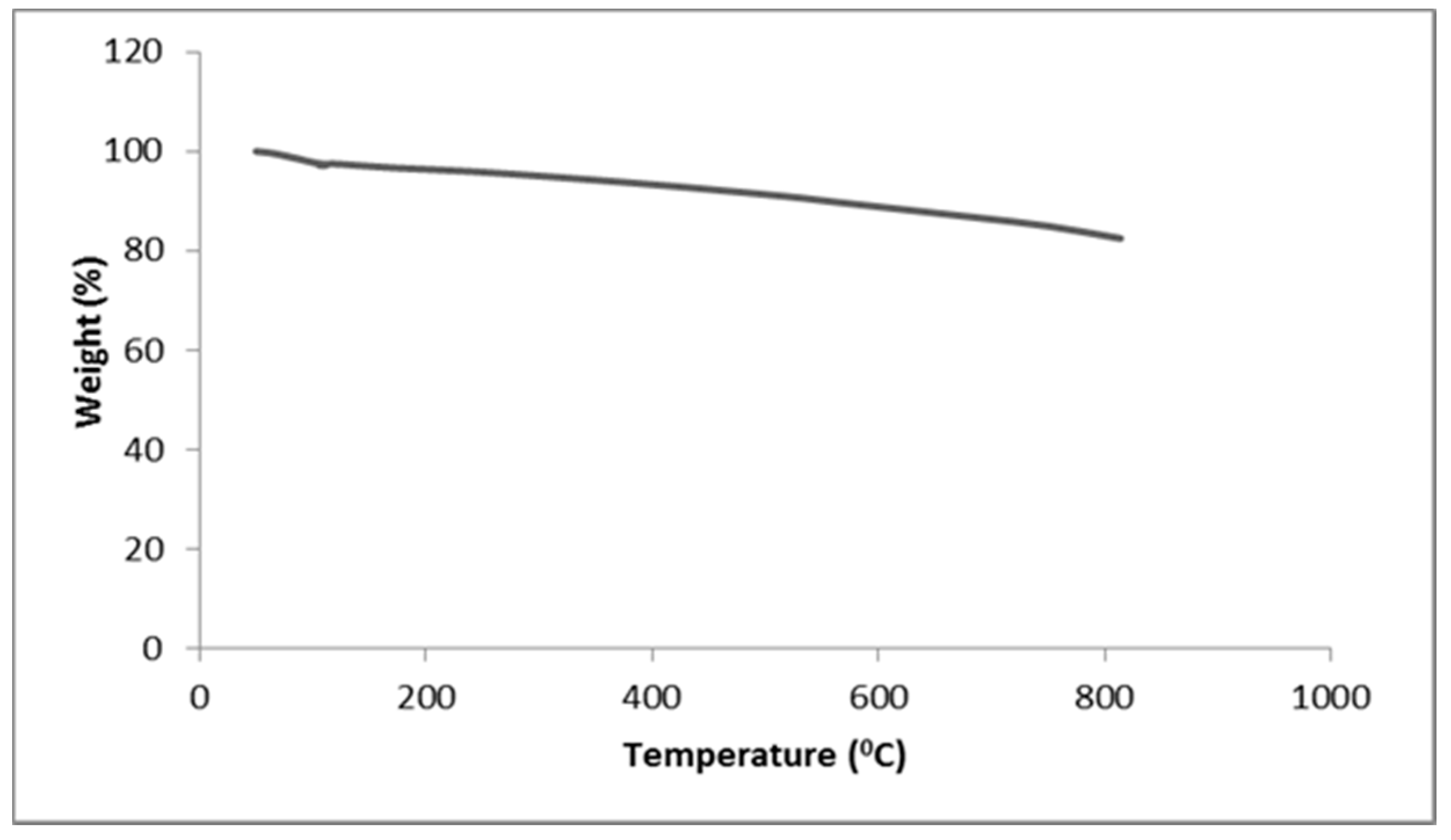
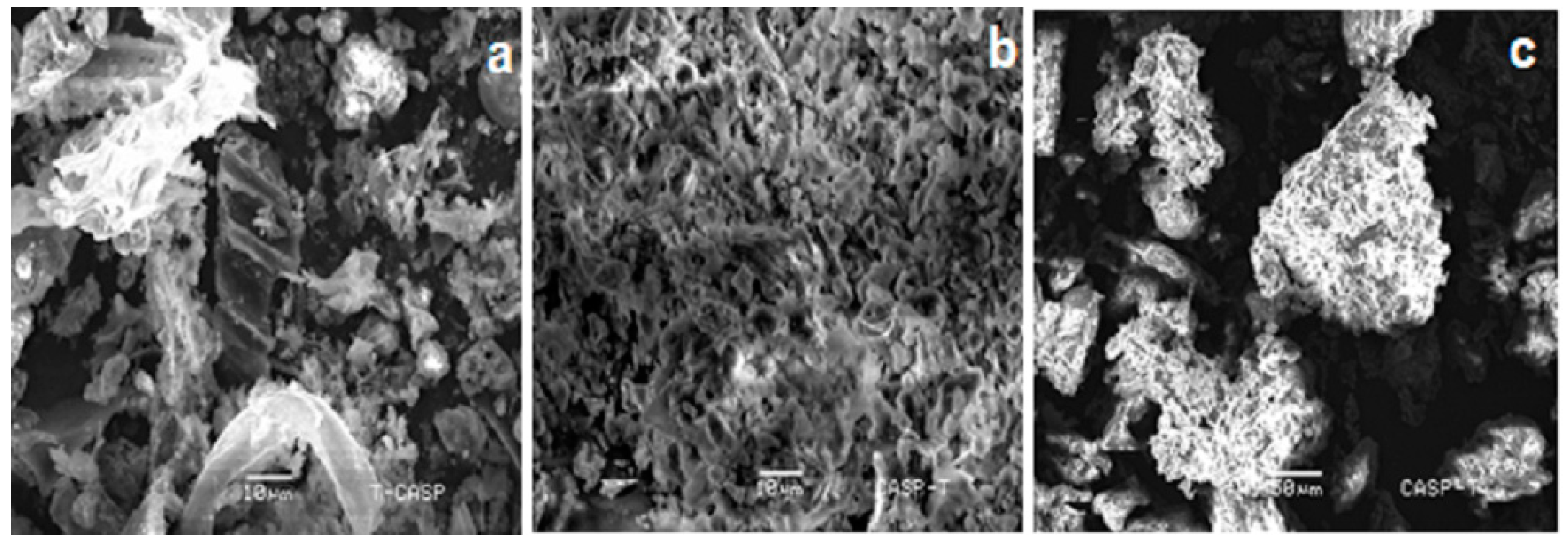
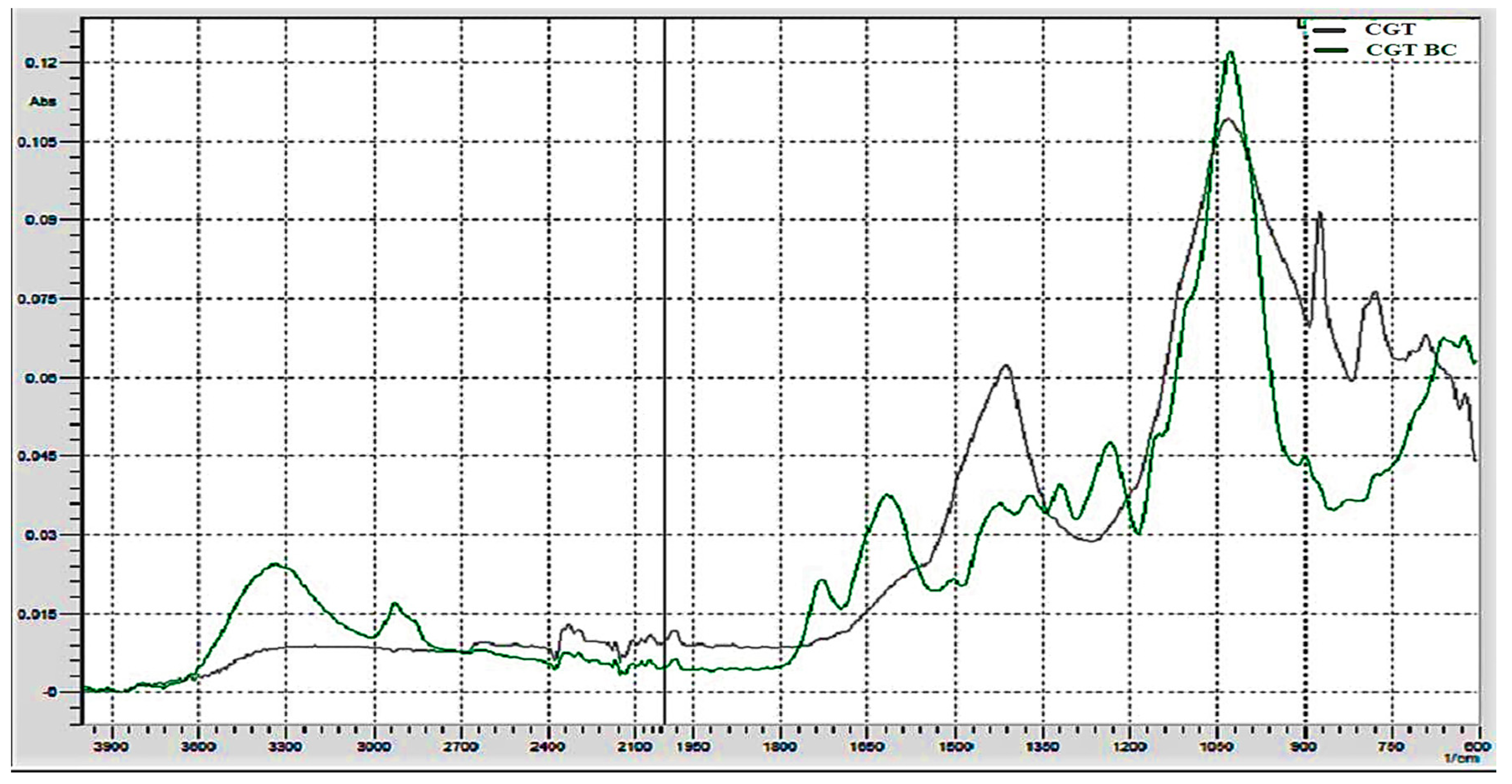
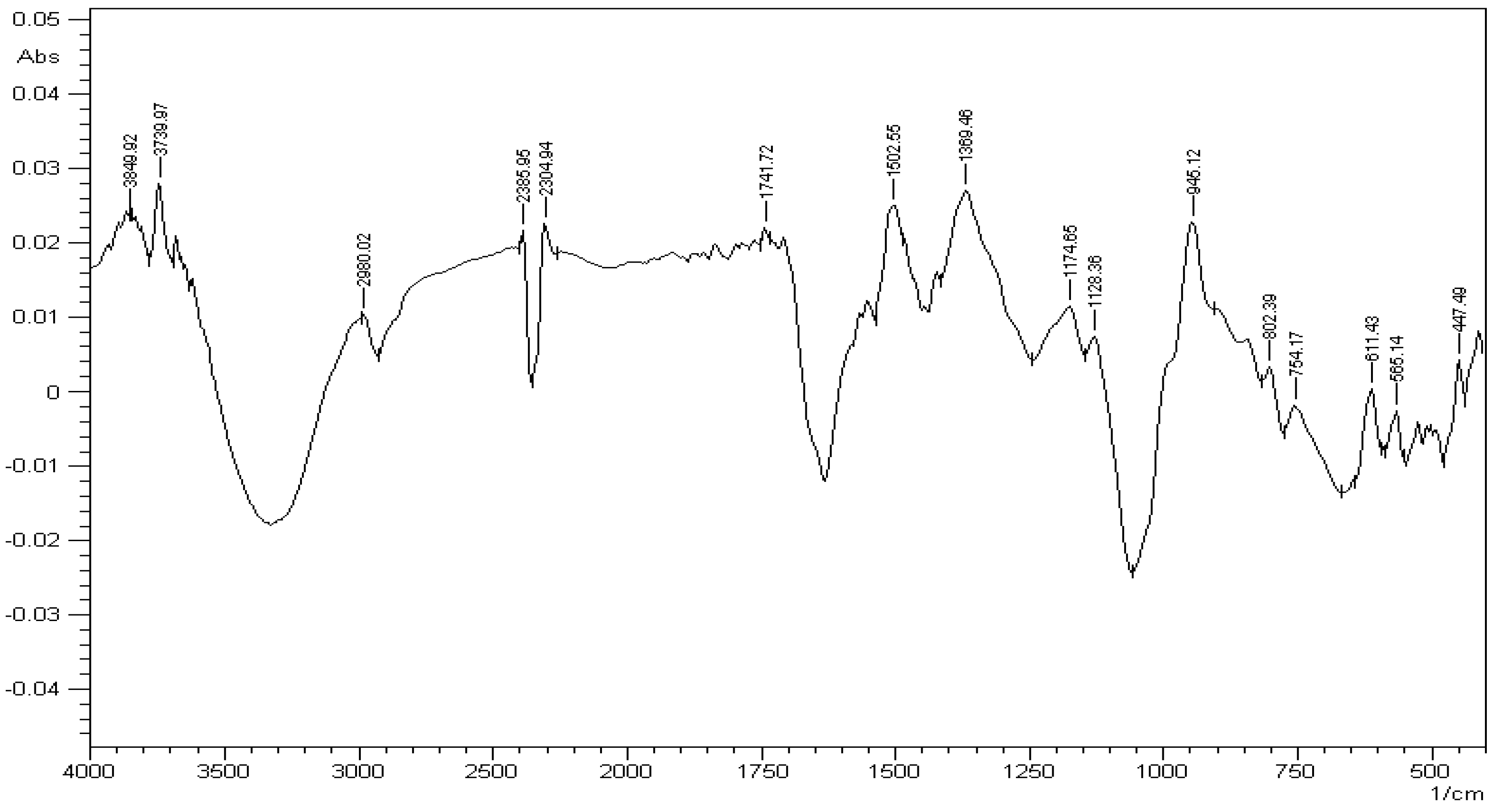

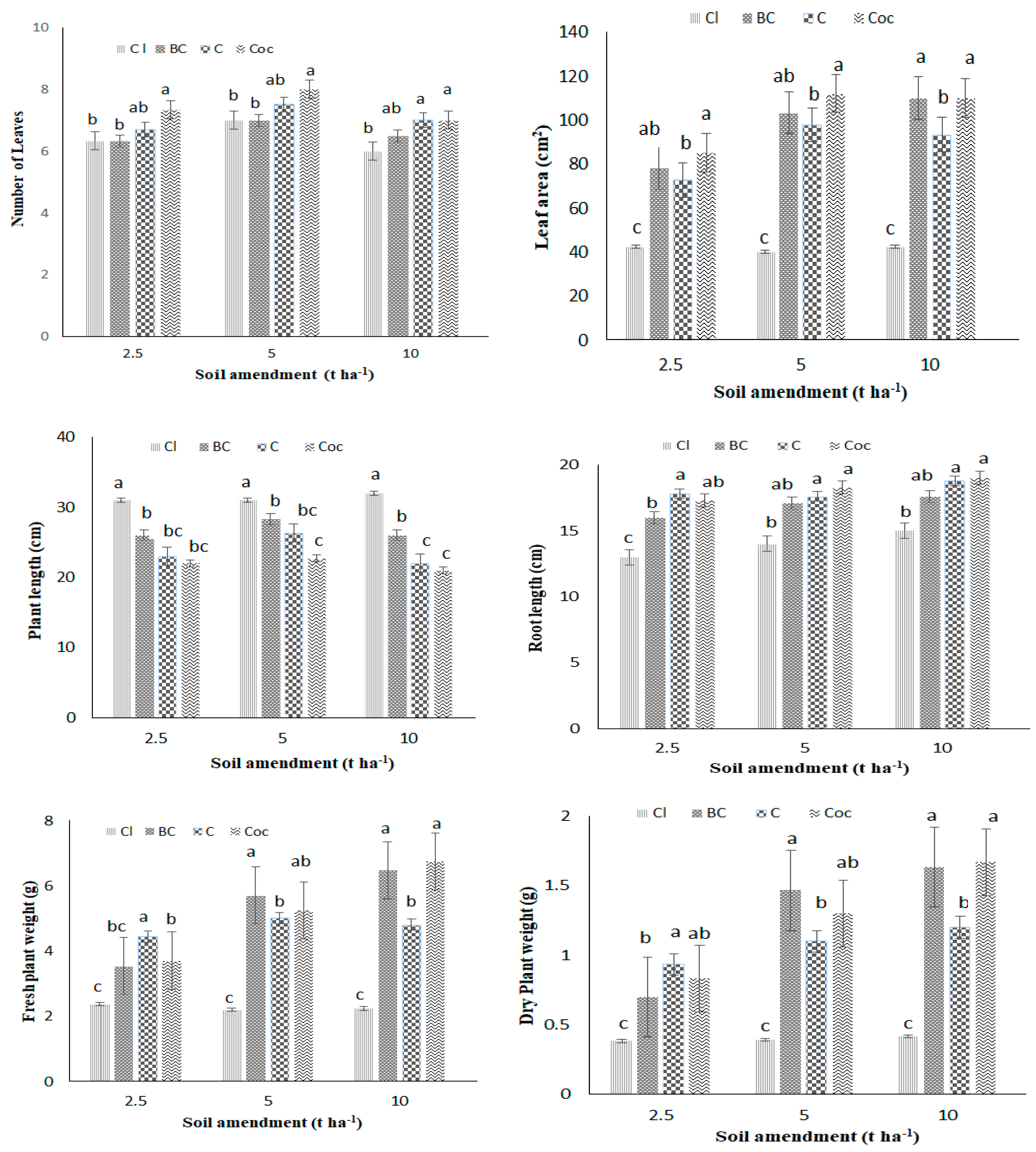
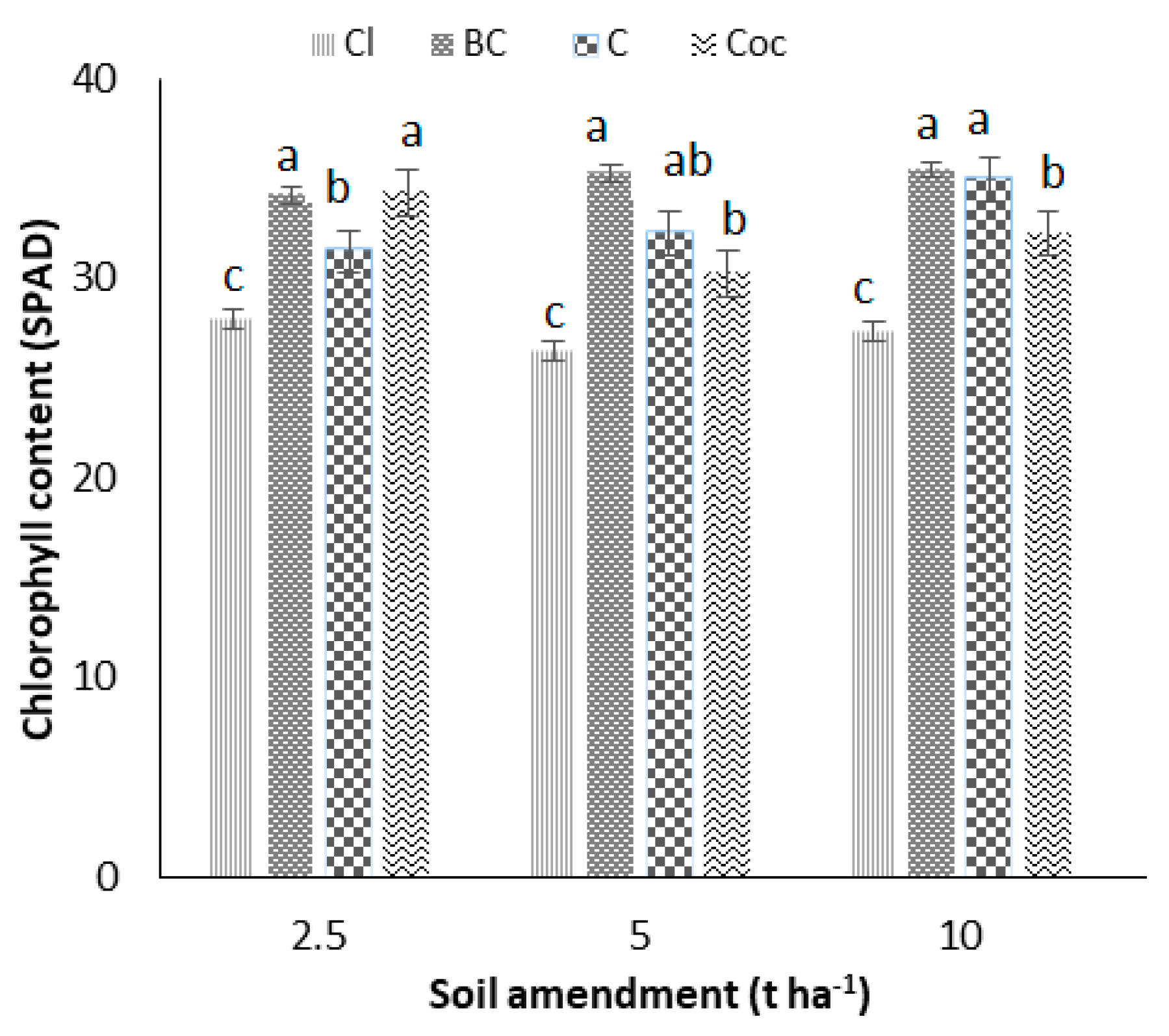
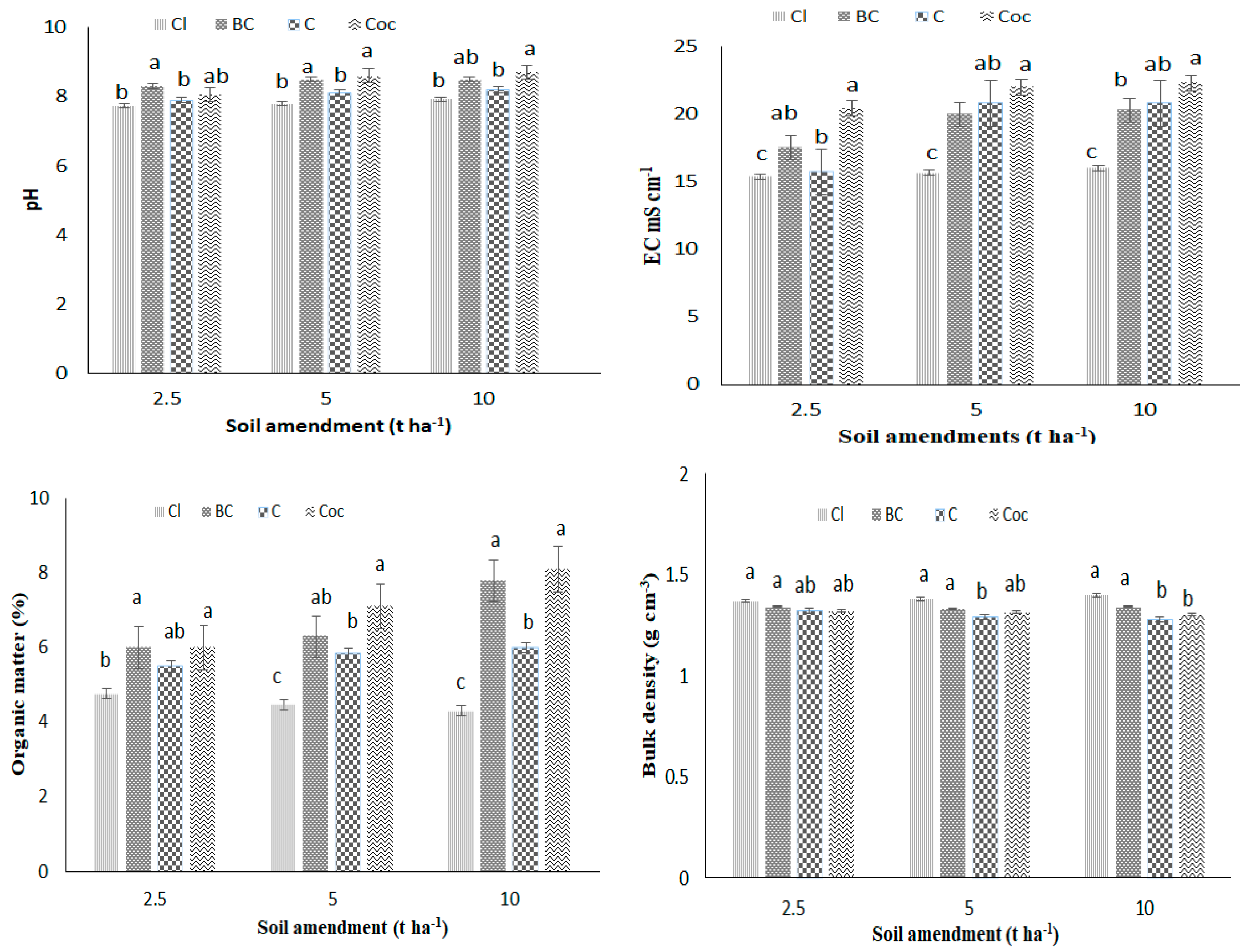
| Feedstocks | Proximate Analysis | |||
|---|---|---|---|---|
| Moisture Content (%) | Ash (%) | Volatile Content (%) | Calorific Value (MJ kg−1) | |
| CGT | 11.50 ± 0.46 | 7.2 ± 0.68 | 68.7 ± 0.52 | 17.99 ± 0.07 |
| FVS | 75.00 ± 3.0 | 5.63 ± 0.57 | 53.75 ± 0.73 | 13.29 ± 0.60 |
| Ultimate Analysis (%) | ||||
| C | H | N | S | |
| CGT | 40.09 ± 0.32 | 5.08 ± 0.41 | 1.20 ± 0.43 | 0.128 ± 0.63 |
| FVS | 40.88 ± 0.5 | 5.25 ± 0.4 | 1.48 ± 0.3 | 2.76 ± 0.4 |
| Physico-Chemical Parameters | Biochar (BC) | Compost (C) | Co-Compost (Coc) |
|---|---|---|---|
| Colour | Black | Dark brown | Black |
| Bulk Density (g m−3) | 0.516 ± 0.03 | 615 ± 0.4 | 452 ± 2.2 |
| Specific Surface Area (m2 g−1) | 5.67 ± 0.2 | 1.23 ± 0.04 | 4.25 ± 0.2 |
| pH | 10.40 ± 0.3 (1:20) | 8.20 ± 0.3 (1:5) | 10.42 ± 0.5 (1:20) |
| Electrical Conductivity (µS cm−1) | 2763 ± 153 | 1280 ± 31 | 1473 ± 45 |
| Cation exchange capacity (cmolc kg−1) | 157.9 ± 4.9 | 44.3 ± 2.9 | 89.3 ± 5.3 |
| Calorific Value (MJ kg−1) | 3.97 ± 0.5 | 12.23 ± 0.3 | 13.57 ± 0.25 |
| Volatile Content (%) | 15.09 ± 0.27 | - | - |
| Ash Content (%) | 78.75 ± 2.12 | 35.20 ± 3.2 | 60.70 ± 4.3 |
| Fixed Carbon (%) | 3.66 ± 0.15 | - | - |
| Elemental composition | |||
| C (%) | 18.69 ± 0.4 | 36.2 ± 0.4 | 29.79 ± 0.6 |
| H (%) | 0.70 ± 0.03 | 4.85 ± 0.02 | 3.73 ± 0.05 |
| N (%) | 0.66 ± 0.02 | 2.24 ± 0.02 | 1.97 ± 0.2 |
| S (%) | 0.21± 0.01 | 0.33± 0.01 | 0.57 ± 0.03 |
| O (%) | 0.99 ± 0.02 | 56.30 ± 0.02 | 63.9 ± 0.1 |
| H/C ratio | 0.44 ± 0.01 | 1.59 ± 0.2 | 1.49 ± 0.03 |
| O/C ratio | 0.04 ± 0.001 | 1.17 ± 0.1 | 1.61 ± 0.2 |
| C/N ratio | 33.20 ± 0.74 | 16.20 ± 0.34 | 15.12 ± 0.62 |
| (O+N)/C ratio | 0.072 ± 0.002 | 1.214 | 1.67 |
Publisher’s Note: MDPI stays neutral with regard to jurisdictional claims in published maps and institutional affiliations. |
© 2021 by the authors. Licensee MDPI, Basel, Switzerland. This article is an open access article distributed under the terms and conditions of the Creative Commons Attribution (CC BY) license (https://creativecommons.org/licenses/by/4.0/).
Share and Cite
Qurat-ul-Ain; Nazir, A.; Capareda, S.C.; Shafiq, M.; Firdaus-e-Bareen. Valorization of Cotton Gin Trash through Thermal and Biological Conversion for Soil Application. Sustainability 2021, 13, 13842. https://doi.org/10.3390/su132413842
Qurat-ul-Ain, Nazir A, Capareda SC, Shafiq M, Firdaus-e-Bareen. Valorization of Cotton Gin Trash through Thermal and Biological Conversion for Soil Application. Sustainability. 2021; 13(24):13842. https://doi.org/10.3390/su132413842
Chicago/Turabian StyleQurat-ul-Ain, Aisha Nazir, Sergio C. Capareda, Muhammad Shafiq, and Firdaus-e-Bareen. 2021. "Valorization of Cotton Gin Trash through Thermal and Biological Conversion for Soil Application" Sustainability 13, no. 24: 13842. https://doi.org/10.3390/su132413842
APA StyleQurat-ul-Ain, Nazir, A., Capareda, S. C., Shafiq, M., & Firdaus-e-Bareen. (2021). Valorization of Cotton Gin Trash through Thermal and Biological Conversion for Soil Application. Sustainability, 13(24), 13842. https://doi.org/10.3390/su132413842





